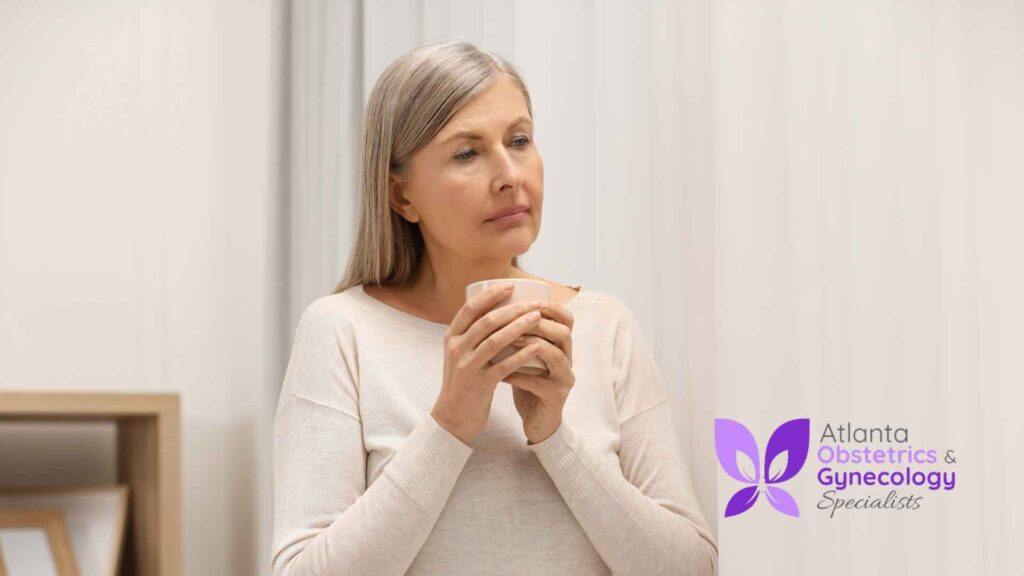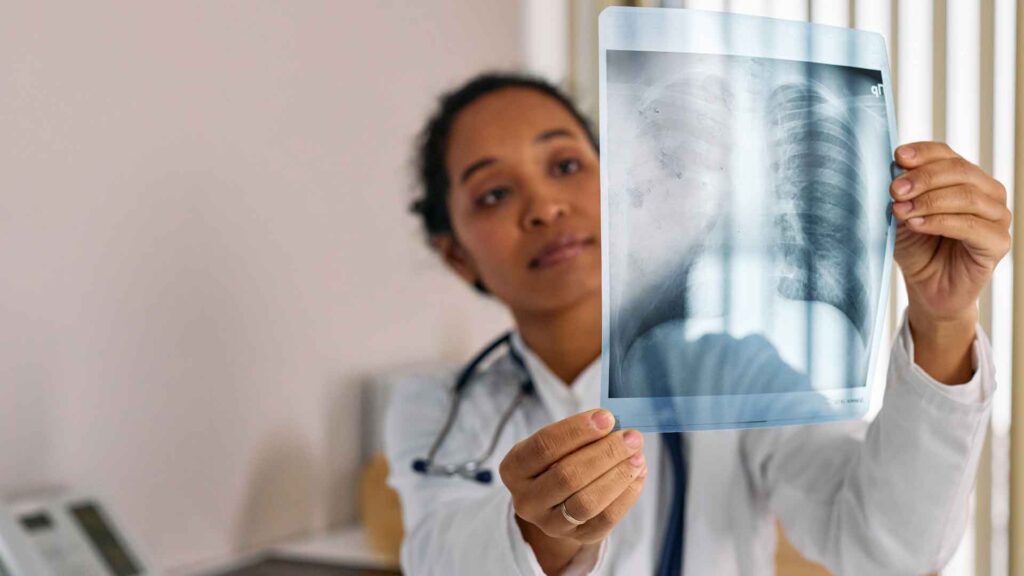Some women start to feel back pain or notice their posture changing as they get older. You might also see friends or relatives being more cautious about slips and falls. These changes can be early signs that it’s time to look closer at bone and muscle health.
Among the many health concerns women face during this stage, our menopause specialists want you to remember bone health. There is a close connection between the physical changes that occur around menopause and the increased risk of osteoporosis. This blog will look into how these body changes affect bone health, what factors raise that risk, and how women can maintain strong, healthy bones through the years.
What Are the Early Warning Signs of Osteoporosis?
Osteoporosis is often called a “silent disease” because bone loss develops slowly, without pain or clear symptoms, until a fracture occurs. Still, subtle changes in how women look or feel can signal that their bones are weakening long before that happens. Recognizing these early signs makes it possible to get tested and start preventive care before serious complications develop.
- Height loss: A gradual decrease in height can be one of the first physical signs of osteoporosis. When the bones in the spine weaken, they begin to compress or collapse slightly, making one appear shorter over time. It’s not always noticeable at first, but it may become apparent when our clothes fit differently, or friends and family start to comment on the difference.
- Stooped posture: A forward curve in the upper back, commonly known as kyphosis can make the shoulders appear rounded or hunched. This posture change results from weakened spinal bones that can no longer support their original alignment. Over time, it can cause discomfort, stiffness, and even difficulty maintaining balance, increasing the likelihood of slips and falls.
- Back and neck pain: Chronic or sudden pain in the back or neck might not always be due to muscle strain. It can be a sign of tiny fractures in the vertebrae, known as compression fractures, which occur when weakened bones begin to collapse. These fractures can cause lingering pain, tenderness, and reduced mobility, affecting daily comfort and activity levels.
- Bone fractures: A bone that breaks from a simple movement like tripping, coughing, or lifting something light is a major red flag for osteoporosis. The hips, wrists, and spine are especially vulnerable. Fragility fractures often occur without major trauma, showing how brittle the bones have become.
Read More: Understanding the Signs and Symptoms of Menopause
Other Possible Signs
Osteoporosis isn’t only about bones breaking or posture changing. It can subtly affect other areas of our body, from dental health to digestion, often going unnoticed until symptoms worsen. Paying attention to these additional signs can encourage early action and timely discussions with gynecologists before significant bone loss occurs.
- Dental problems: Bone density doesn’t only matter in the spine or hips; it affects the jaw, too. Receding gums, loose teeth, or changes in how dentures fit can indicate bone loss in the jaw. These symptoms may appear years before more severe osteoporosis develops.
- Shortness of breath: As spinal compression progresses, the chest cavity may lose space, limiting lung expansion. This can lead to shortness of breath or fatigue, even during mild physical activity. It’s an overlooked but important indicator of how bone loss can impact overall body function.
- Gastrointestinal issues: Changes in spinal structure can also affect the abdomen, leaving less room for internal organs. This may cause a feeling of fullness after small meals or general digestive discomfort. Though it might seem unrelated, these signs often accompany vertebral compression linked to osteoporosis.
- Brittle nails: Weak or easily broken nails might signal reduced mineral absorption or overall structural weakness. Nails and bones share key building materials like collagen and calcium, so their condition can reflect our internal bone health.
- Weak grip strength: A declining ability to hold or carry items may point to lower muscle mass and bone density. Studies have found that grip strength correlates strongly with overall skeletal health, making it a useful indicator of osteoporosis risk, especially in postmenopausal women.
The Link Between Menopause and Changes in Bone Strength
Many women begin to wonder how the signs of bone changes develop after menopause. The answer lies in how this natural transition influences the body’s ability to maintain and rebuild bone tissue. Over time, the internal balance that keeps bones strong starts to shift, making it easier for bone loss to occur if preventive steps are not taken.
- Hormonal DeclineWhen estrogen levels drop after menopause, bone breakdown begins to occur faster than new bone can form. This imbalance results in gradual bone thinning, making bones more fragile and prone to fractures even from mild stress or minor falls.
- Metabolic SlowdownAfter menopause, the body’s metabolism naturally slows, which can influence how nutrients are processed and distributed. A slower metabolic rate may reduce the body’s ability to rebuild bone tissue as efficiently as before. This gradual change contributes to weaker bone renewal over time, increasing the likelihood of density loss even with proper nutrition.
How Soon After Menopause Does Osteoporosis Start?
The rate of bone loss increases sharply in the years following menopause. Studies show that women can lose about 1% to 5% of bone mass per year during the first five to seven years after menopause, which can add up to a total loss of 20% to 25% of bone density during that period.
This process doesn’t happen overnight. The rate of bone loss can also vary based on different factors. That’s why early evaluation by an OBGYN or specialist is crucial. Detecting changes through bone density screening allows timely interventions before osteoporosis fully develops.
Major Contributors to Bone Weakening After Menopause
While menopause itself triggers biological changes that affect bone structure, it’s not the only factor influencing bone strength. Several external and personal elements can either worsen or slow down bone loss. Recognizing these contributors helps women take a more proactive approach to protecting long-term skeletal health.
- Age: As we grow older, our bones gradually lose density and strength. This decline happens because bone renewal slows down while natural wear continues. Over time, even minor stress can have a greater impact, increasing the likelihood of fractures.
- Genetics: Family history plays a significant role in determining bone health. Women whose mothers or grandmothers had osteoporosis or hip fractures are more likely to experience similar issues, suggesting that bone density and strength can be inherited.
- Nutrition: Our bones rely on steady nourishment to stay strong. Diets lacking in calcium, vitamin D, or protein can weaken bone structure, as these nutrients are essential for bone formation and repair. Insufficient intake can also affect the body’s ability to absorb minerals effectively.
- Lifestyle: Limited physical activity, particularly weight-bearing exercises, can slow bone renewal. Smoking interferes with mineral absorption, while frequent alcohol consumption disrupts the natural balance of hormones involved in bone metabolism. Together, these habits can contribute to faster bone decline.
- Medical Conditions: Certain illnesses and long-term medications can impact how bones renew and rebuild. Conditions like hyperthyroidism and treatments involving corticosteroids or anticonvulsants can alter bone metabolism, making bones more fragile over time.
Can You Rebuild Bone Density After Menopause?
Yes, it is possible to rebuild some bone density after menopause. While bone loss naturally occurs with age, the body can still form new bone tissue when supported by the right combination of treatments, proper nutrition, and regular physical activity. With consistent care, it’s possible to slow further loss and even regain some strength in your bones.
Bone renewal remains an active process throughout life. Specialized cells, called osteoblasts, continue producing new bone even after menopause. Stimulating these cells through regular movement, proper posture, and maintaining muscle mass helps support ongoing bone remodeling. Adequate hydration and balanced micronutrient intake also strengthen the bone matrix and maintain elasticity, reducing the risk of microfractures over time.
Though full restoration may not always be possible, consistent care and a proactive approach can significantly improve bone density and reduce fracture risks, helping women maintain mobility and confidence well into their later years.
Consulting Your OBGYN for Preventive Care
Regular checkups with OBGYN specialists are essential for protecting bone health after menopause. Your doctor can help identify, assess risk factors, and recommend ways to maintain strong bones through the years. Preventive care not only focuses on treatment but also on understanding the changes happening within our bodies.
- Screening: A bone density test, such as a DXA scan, helps measure how strong your bones are and whether you’re at risk for osteoporosis. If you’re postmenopausal or have risk factors like family history or prior fractures, your OBGYN may suggest this test to detect issues.
- Treatment: When osteoporosis or bone loss is confirmed, your doctor can recommend several medical approaches to strengthen bones and reduce fracture risk. Each treatment targets a specific cause or effect of bone loss, helping restore balance and protect long-term bone structure.
- Bisphosphonates: These are the most common medications prescribed to slow bone breakdown. They help maintain bone density and reduce the likelihood of fractures, especially in the spine and hips.
- Hormone Therapy: Menopausal hormone therapy helps manage symptoms of menopause while also supporting bone health. It works by replacing the estrogen that the body stops producing after menopause, helping maintain the natural balance between bone loss and bone formation. By slowing down the rate of bone thinning, MHT reduces the risk of fractures and supports stronger, healthier bones in postmenopausal women.
- Selective Estrogen Receptor Modulators (SERMs): SERMs act like estrogen in the bones but not in other parts of the body. They help preserve bone mass and are an alternative for women who cannot undergo standard hormone therapy.
- Bone-Building Medications: In more severe cases, medications such as teriparatide or abaloparatide may be used to actively stimulate new bone formation, improving both density and strength.
- Daily Habits and Movement: Beyond medication, your OBGYN may recommend consistent, moderate activity like brisk walking, light resistance training, or posture exercises to support bone endurance and muscle balance. Regular movement helps improve stability, coordination, and overall mobility, reducing the risk of falls.
Also Read: What are the Signs That You Need Hormone Replacement Therapy?
Consistent preventive care makes a lasting difference in bone health. At Atlanta Obstetrics and Gynecology Specialists, we’re dedicated to helping women stay strong and healthy beyond menopause. Our experienced team provides comprehensive screening, personalized care plans, and ongoing guidance to support your well-being. Schedule a consultation today to take the next step in protecting your bone health.

